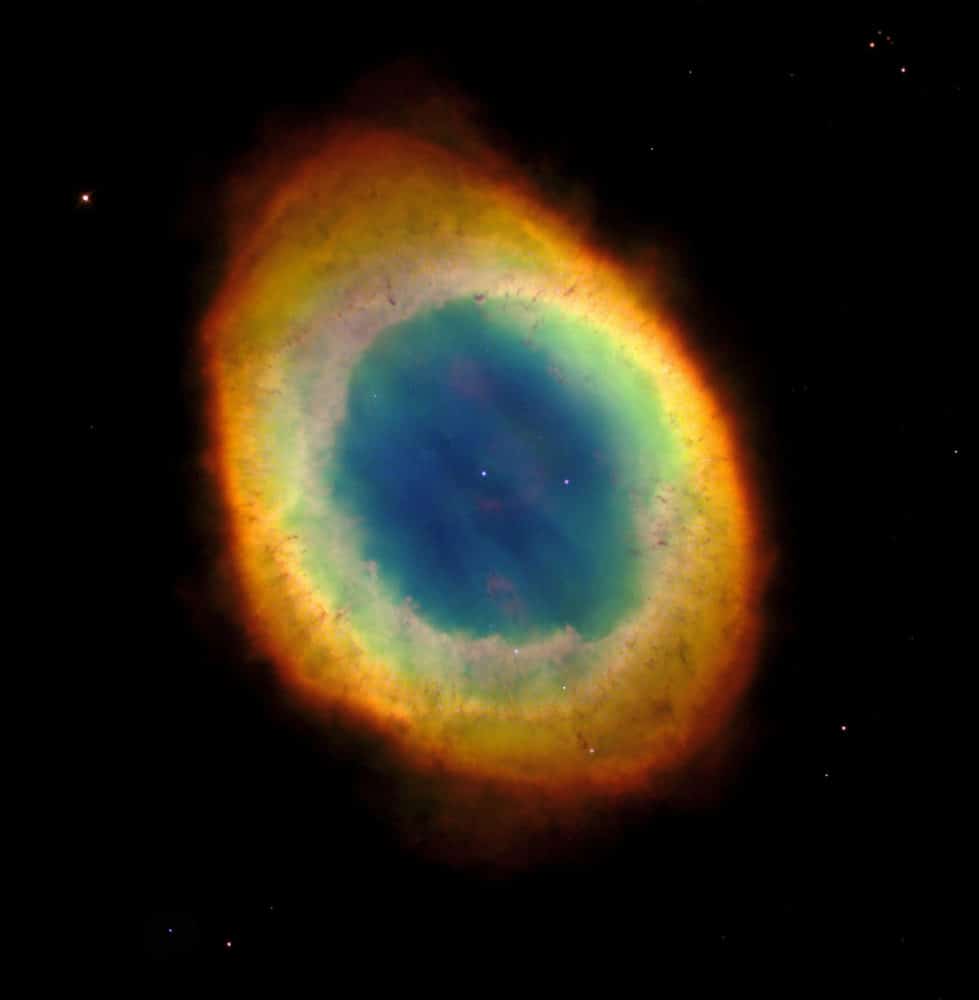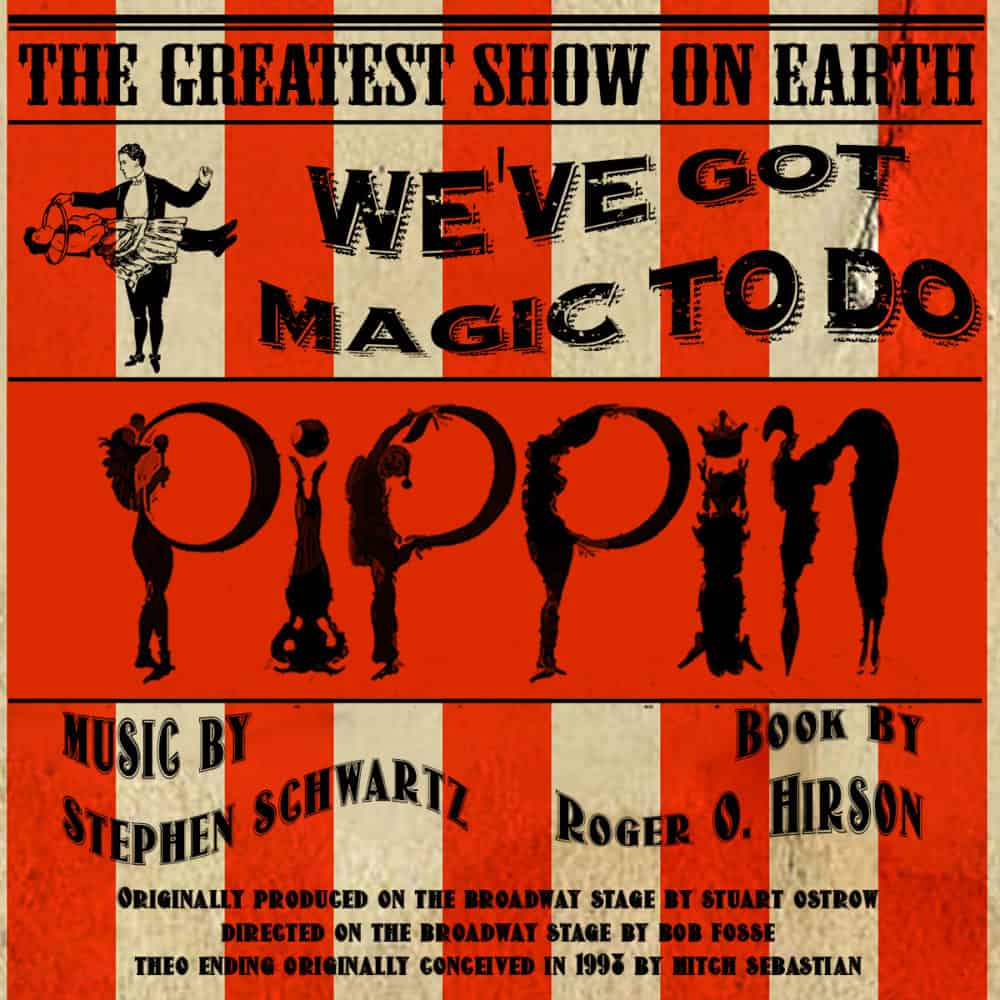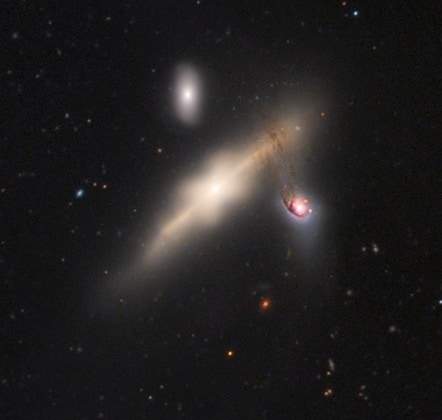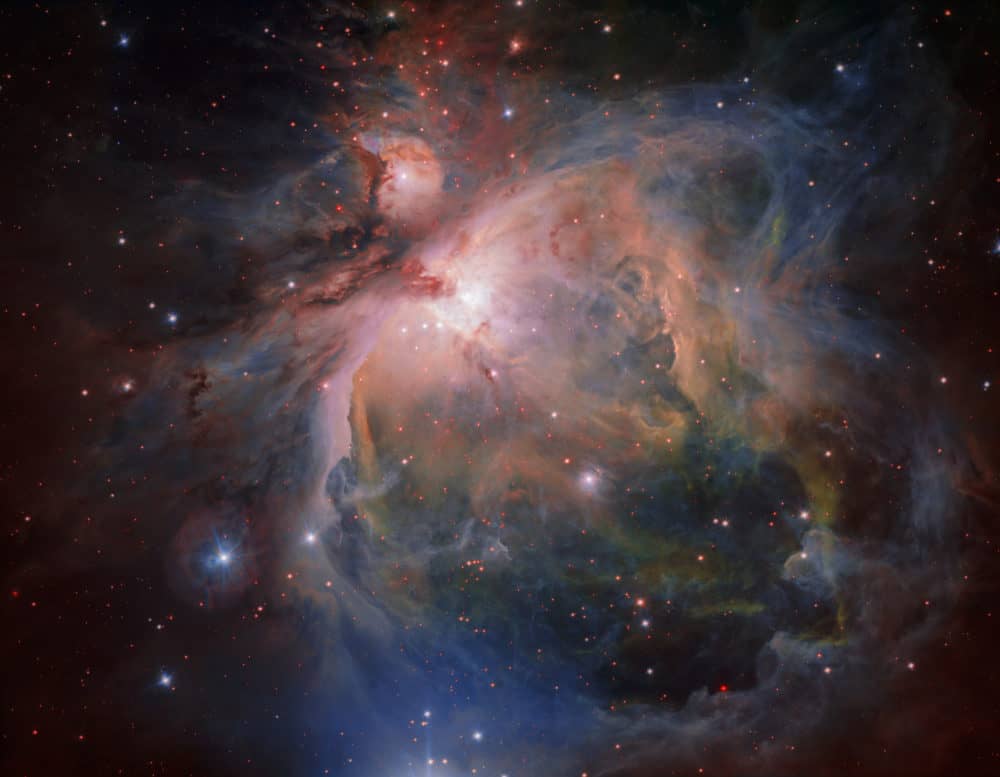Blog
https://www.youtube.com/watch?v=PBZ7DJMHp88
more...The Ring Nebula (also catalogued as Messier 57, M57 or NGC 6720) is a planetary nebula in the northern constellation of Lyra. Such objects are formed when a shell of ionized gas is expelled into the surrounding interstellar medium by a star at the end of its asymptotic giant branch phase, in the last stages of its evolution before becoming a white dwarf. This nebula was discovered by the French astronomer Charles Messier while searching for comets in late January 1779. Messier’s report of his independent discovery of Comet Bode reached fellow French astronomer Antoine Darquier de Pellepoix two weeks later, who then independently rediscovered the nebula while following the comet. Darquier later reported that it was “…as large as Jupiter and resembles a planet which is fading” (which may have contributed to the use of the “planetary nebula” terminology). It would be entered into Messier’s catalogue as the 57th object. Messier and German-born astronomer William Herschel speculated that the nebula was formed by multiple faint stars that were unresolvable with his telescope.
M57 is 0.787 kpc (2,570 light-years) from Earth. It has a visual magnitude of 8.8v and photographic magnitude of 9.7p. Photographs taken over a period of 50 years show the rate of nebula expansion is roughly 1 arcsecond per century, which corresponds to spectroscopic observations as 20–30 km s−1. M57 is illuminated by a central white dwarf or planetary nebula nucleus (PNN) of 15.75v visual magnitude.
more...
Muhal Richard Abrams (born Richard Lewis Abrams; September 19, 1930 – October 29, 2017) was an American educator, administrator, composer, arranger, clarinetist, cellist, and jazz pianist in the free jazz medium. He recorded and toured the United States, Canada and Europe with his orchestra, sextet, quartet, duo and as a solo pianist. His musical affiliations constitute a “who’s who” of the jazz world, including Max Roach, Dexter Gordon, Eddie “Lockjaw” Davis, Art Farmer, Sonny Stitt, Anthony Braxton, and The Art Ensemble of Chicago.
Abrams’s mother, Edna, was born in Memphis. His father, Milton, was born in Alabama and moved with his parents to Chicago. Richard Lewis Abrams was born there, the second of nine children, on September 19, 1930. His father became a self-employed handyman; his mother was a housewife. “Abrams’s paternal grandfather was ‘what you call a junk man’, selling the fruits of neighborhood foraging. Abrams and his brother would pull the cart around the neighborhood, eventually arriving at a junk-yard on State Street, where the items would be sold.” Abrams first attended Forrestville public school in Chicago. He grew up in a gang area; truancy and fighting meant that he was sent to Moseley School, a reformatory school for boys. There, in addition to strict discipline, he was taught about black histories. He later moved on to DuSable High School. Although he was aware of the strong music program there, led by Walter Dyett, Abrams preferred playing sports, so did not participate in Dyett’s classes. Among the future musicians Abrams met at the school were Charles Davis, Richard Davis, John Gilmore, Johnny Griffin, Laurdine Patrick, and Julian Priester.
more...George Lowen Coxhill (19 September 1932 – 10 July 2012), generally known as Lol Coxhill, was an English free improvising saxophonist and raconteur. He played the soprano or sopranino saxophone.
Coxhill was born to George Compton Coxhill and Mabel Margaret Coxhill (née Motton) at Portsmouth, Hampshire, UK. He grew up in Aylesbury, Buckinghamshire, and bought his first saxophone in 1947. After national service he became a busy semi-professional musician, touring US airbases with Denzil Bailey’s Afro-Cubists and the Graham Fleming Combo. In the 1960s he played with visiting American blues, soul and jazz musicians including Rufus Thomas, Mose Allison, Otis Spann, and Champion Jack Dupree. He also developed his practice of playing unaccompanied solo saxophone, often busking in informal performance situations. Other than his solo playing, he performed mostly as a sideman or as an equal collaborator, rather than a conventional leader – there was no regular Lol Coxhill Trio or Quartet as would normally be expected of a saxophonist. Instead he had many intermittent but long-lasting collaborations with like-minded musicians.
more...Cora “Lovie” Austin (September 19, 1887 – July 8, 1972) was an American Chicago bandleader, session musician, composer, singer, and arranger during the 1920s classic blues era. She and Lil Hardin Armstrong are often ranked as two of the best female jazz blues piano players of the period.
She was born Cora Taylor in Chattanooga, Tennessee. Lovie grew up with eight brothers and sisters. She took the name Cora Calhoun in her teens from an early marriage; she was married for a short time to a movie house operator in Detroit and then later married a vaudeville performer, Phillip Austin. She studied music theory at Roger Williams University and Knoxville College in Knoxville, Tennessee which was uncommon for African American woman and jazz musicians alike during the time.
In 1923, Lovie Austin decided to make Chicago her home, and she lived and worked there for the rest of her life. She was often seen racing around town in her Stutz Bearcat with leopard skin upholstery, dressed to the teeth. Her early career was in vaudeville, where she played piano and performed in variety acts. Accompanying blues singers was Lovie’s specialty, and can be heard on recordings by Ma Rainey (“Moonshine Blues), Ida Cox (“Wild Women Don’t Have the Blues“), Ethel Waters (“Craving Blues”), and Alberta Hunter (“Sad ‘n’ Lonely Blues”).
more...This striking image, taken with the FORS2 instrument on the Very Large Telescope, shows a beautiful yet peculiar pair of galaxies, NGC 4438 and NGC 4435, nicknamed The Eyes. The larger of these, at the top of the picture, NGC 4438, is thought to have once been a spiral galaxy that was strongly deformed by collisions in the relatively recent past. The two galaxies belong to the Virgo Cluster and are about 50 million light-years away.
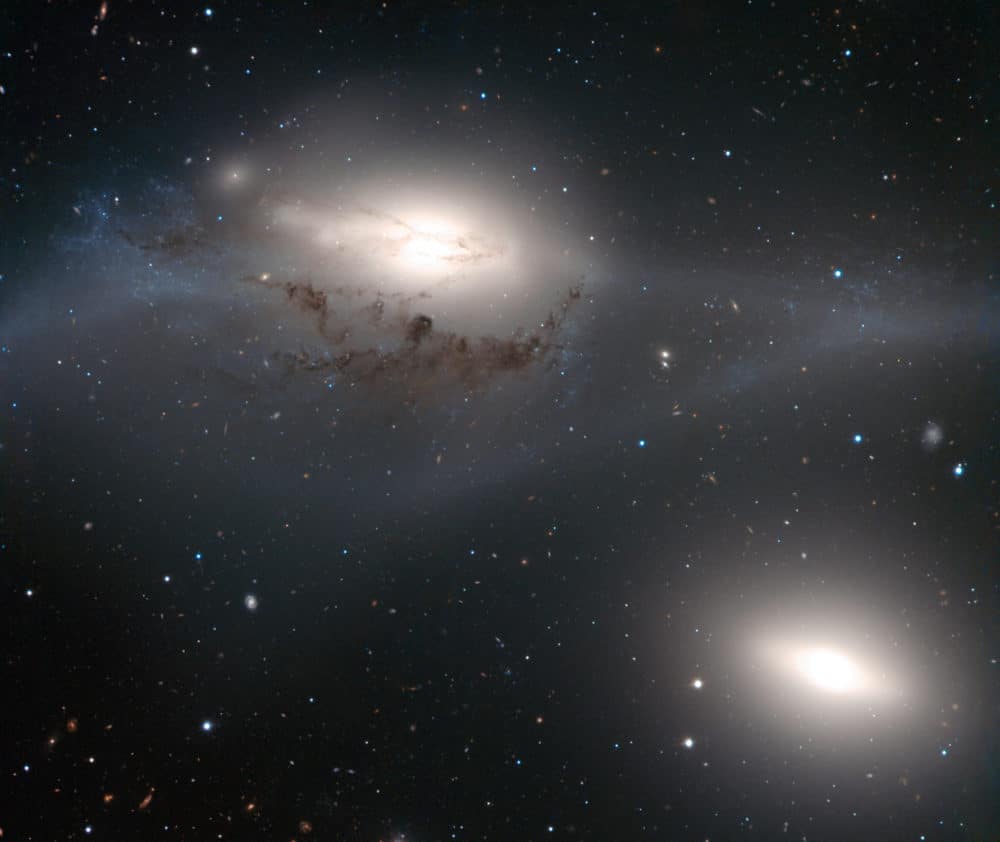
This striking image, taken with the FORS2 instrument on the Very Large Telescope, shows a beautiful yet peculiar pair of galaxies, NGC 4438 and NGC 4435, nicknamed The Eyes. The larger of these, at the top of the picture, NGC 4438, is thought to have once been a spiral galaxy that was strongly deformed by collisions in the relatively recent past. The two galaxies belong to the Virgo Cluster and are about 50 million light-years away.
María del Rocío Trinidad Mohedano Jurado (Spanish pronunciation: [roˈθi.o xuˈɾaðo], born 18 September 1946 – died 1 June 2006) was a Spanish singer and actress. She was born in Chipiona (Cádiz) and nicknamed “La más grande” (“The Greatest”).
She was once married to boxer Pedro Carrasco, with whom she had a daughter, Rocío Carrasco. Divorced, she married bullfighter José Ortega Cano, and they adopted two children, Gloria Camila Ortega Mohedano and José Fernando Ortega Mohedano.
In 2000 in New York, she won the prize La voz del Milenio for best female voice of the 20th century. Rocio Jurado sold more than 25 million records, and she received 150 gold discs and 63 platinum discs.
more...
Born : September 18, 1929 in Byhalia, Mississippi. Died : September 05, 1994 in Chicago, Illinois.
American blues guitarist, harmonicist, bassist, arranger and singer. Associated with the Chicago blues scene of the 1960’s and on, having backed and played with countless Chicago notables. Brother of guitarist/bassist Dave Myers.
more...https://www.youtube.com/watch?v=ovhc7dEAjEs
more...NGC 128 is a lenticular galaxy in the constellation Pisces. It is approximately 190 million light-years from earth and has a diameter of about 165,000 light years. NGC 128 with smaller galaxies NGC 130 (left) and NGC 127 (right).
NGC 128 was discovered by astronomer William Herschel on 25 December 1790 using a reflecting telescope with an aperture of 18.7 inches. At the time of discovery, its coordinates were recorded as 00h 22m 05s, +87° 54.6′ -20.0″.
more...Earl Charles Barrington May (September 27, 1927 – January 4, 2008) was an American jazz bassist.
May was born and raised in New York City, where he began playing professionally in the early 1950s, learning to play left-handed using a double bass strung for a right-handed musician. He studied under Charles Mingus and played locally with Miles Davis, Lester Young, Gene Ammons, Sonny Stitt, and Mercer Ellington. Through most of the 1950s he played in a trio with Billy Taylor, and also worked later in the 1950s with John Coltrane and Chet Baker.
From 1959 to 1963 he played behind Gloria Lynne, and in that decade also worked with Dave McKenna, Herman Foster, Shirley Scott, Stanley Turrentine, Herbie Mann, Mose Allison, and Earl Hines. In the early 1970s he began playing electric bass in addition to the double-bass, and played in that decade with Dizzy Gillespie, Johnny Hartman, Joe Newman, Archie Shepp, Frank Foster, Mickey Tucker, and Ruby Braff.
In the 1980s he did work with musicals both on Broadway and on tour, including Sophisticated Ladies and Big Deal, in addition to work with George Benson early in the decade and Charles Brownlater in the decade. Credits in the 1990s and 2000s included work with Dave Van Ronk, Doc Cheatham, Benny Waters, Marlena Shaw, Irvin Stokes, a trio with Jane Jarvis and Benny Powell, Eddie Locke, Charles McPherson, and the international tour of the Statesmen of Jazz.
more...Eugene McDuff (September 17, 1926 – January 23, 2001), known professionally as “Brother” Jack McDuff or “Captain” Jack McDuff, was an American jazz organist and organ trio bandleader who was most prominent during the hard bop and soul jazz era of the 1960s, often performing with an organ trio. He is also credited with giving guitarist George Benson his first break.
Content Born Eugene McDuffy in Champaign, Illinois, McDuff began playing bass, appearing in Joe Farrell’s group. Encouraged by Willis Jackson in whose band he also played bass in the late 1950s, McDuff moved to the organ and began to attract the attention of Prestige while still with Jackson’s group. McDuff soon became a bandleader, leading groups featuring a young George Benson on guitar, Red Holloway on tenor saxophone and Joe Dukeson drums.
McDuff recorded many classic albums on Prestige, including his debut solo Brother Jack in 1960; The Honeydripper (1961), with tenor saxophonist Jimmy Forrest and guitarist Grant Green; Brother Jack Meets The Boss (1962), featuring Gene Ammons; Screamin’ (1962), with alto saxophonist Leo Wright and guitarist Kenny Burrell; and Brother Jack McDuff Live! (1963),[4] featuring Holloway and Benson, which includes his biggest hit, “Rock Candy”.
https://www.youtube.com/watch?v=SvFuh-o2w7E
more...Hiram King “Hank” Williams (September 17, 1923 – January 1, 1953 Mount Olive, Butler County, Alabama) was an American singer-songwriter and musician. Regarded as one of the most significant and influential American singers and songwriters of the 20th century, Williams recorded 35 singles (five released posthumously) that reached the Top 10 of the Billboard Country & Western Best Sellers chart, including 11 that ranked number one (three posthumously).
Born in Mount Olive, Butler County, Alabama, Williams relocated to Georgiana with his family, where he met Rufus Payne, who gave him guitar lessons in exchange for meals or money. Payne had a major influence on Williams’ later musical style, along with Roy Acuff and Ernest Tubb. Williams would later relocate to Montgomery, where he began his music career in 1937, when producers at radio station WSFA hired him to perform and host a 15-minute program. He formed the Drifting Cowboys backup band, which was managed by his mother, and dropped out of school to devote his time to his career.
When several of his band members were conscripted into military service during World War II, Williams had trouble with their replacements, and WSFA terminated his contract because of his alcohol abuse. Williams eventually married Audrey Sheppard, who was his manager for nearly a decade. After recording “Never Again” and “Honky Tonkin'” with Sterling Records, he signed a contract with MGM Records. In 1947, he released “Move It on Over“, which became a hit, and also joined the Louisiana Hayride radio program.
One year later, he released a cover of “Lovesick Blues” recorded at Herzog Studio in Cincinnati, which carried him into the mainstream of music. After an initial rejection, Williams joined the Grand Ole Opry. He was unable to read or notate music to any significant degree. Among the hits he wrote were “Your Cheatin’ Heart“, “Hey, Good Lookin’“, and “I’m So Lonesome I Could Cry“.
Years of back pain, alcoholism and prescription drug abuse severely compromised his health. In 1952 he divorced Sheppard and was dismissed by the Grand Ole Opry because of his unreliability and alcohol abuse. On New Year’s Day 1953, he died suddenly while traveling to a concert in Canton, Ohio at the age of 29. Despite his short life, Williams is one of the most celebrated and influential popular musicians of the 20th century, especially in regards to country music.
Many artists covered songs Williams wrote and recorded. He influenced Elvis Presley, Johnny Cash, Chuck Berry, Jerry Lee Lewis, Bob Dylan, George Jones, Charley Pride,and The Rolling Stones, among others. Williams was inducted into the Country Music Hall of Fame (1961), the Songwriters Hall of Fame (1970), and the Rock and Roll Hall of Fame (1987). The Pulitzer Prize jury in 2010 awarded him a posthumous special citation “for his craftsmanship as a songwriter who expressed universal feelings with poignant simplicity and played a pivotal role in transforming country music into a major musical and cultural force in American life.”
more...OmegaCAM — the wide-field optical camera on ESO’s VLT Survey Telescope (VST) — has captured the spectacular Orion Nebula and its associated cluster of young stars in great detail, producing this beautiful new image. This famous object, the birthplace of many massive stars, is one of the closest stellar nurseries, at a distance of about 1350 light-years.
The Orion Nebula (also known as Messier 42, M42, or NGC 1976) is a diffuse nebula situated in the Milky Way, being south of Orion’s Belt in the constellation of Orion. It is one of the brightest nebulae, and is visible to the naked eye in the night sky. M42 is located at a distance of 1,344 ± 20 light years and is the closest region of massive star formation to Earth. The M42 nebula is estimated to be 24 light years across. It has a mass of about 2,000 times that of the Sun. Older texts frequently refer to the Orion Nebula as the Great Nebula in Orion or the Great Orion Nebula.
more...More Posts
- World Fusion Varijashree Venugopal
- Daily Roots Scientist
- Happy St Nicholas Day 2024
- Temple Israel Erev Shabbat Service
- Cosmos NGC 300
- Joseph Lamb
- Miroslav Vitouš
- Dave Brubeck
- Flamenco Fridays Camerón y Tomatito
- Daily Roots Scientist
- Mandela Education
- Information vs Wisdom
- Cosmos Arp 273
- Camarón de la Isla
- Little Richard
- Sonny Boy Williamson II
- Francesco Scarlatti
- Egberto Gismonti
- World Music Ibrahim Maalouf
- Daily Roots Scientist
